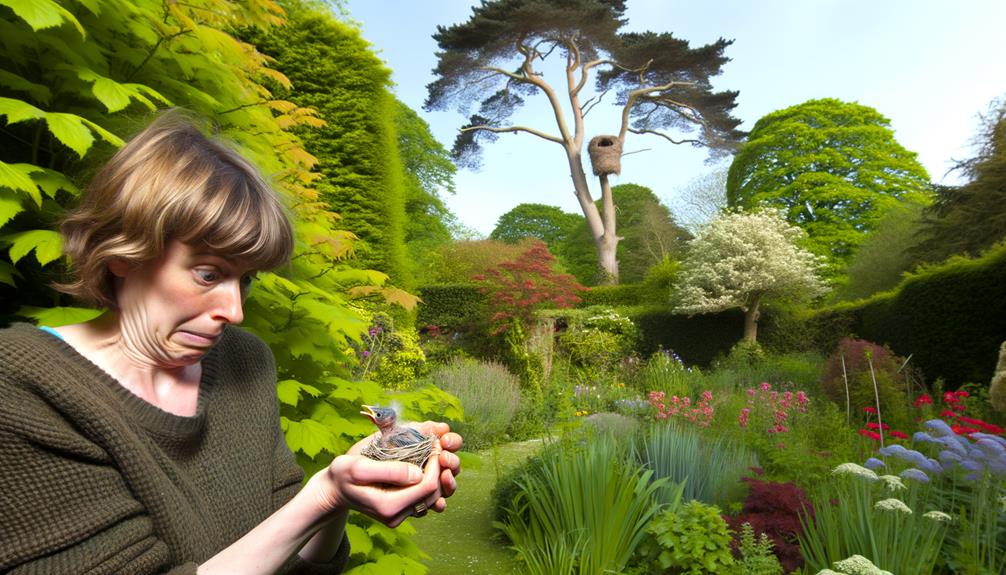7 Steps to Help a Baby Sparrow That Fell From Its Nest
To start, assess the situation. Observe the baby sparrow's physical condition and its surroundings.
Determine if it's a nestling or fledgling. Check for visible injuries like broken wings or bleeding.
If uninjured, locate the nest within a 30-foot radius in trees, shrubs, or building eaves. Carefully handle the bird, supporting its thorax and abdomen, and place it back in the nest if possible.
Use a clean, soft cloth to create a temporary nest if you can't find the original. Contact a wildlife rehabilitator if the bird exhibits signs of injury, dehydration, or respiratory distress.
Additional guidance awaits your attention.

Key Takeaways
- Observe the baby sparrow for any visible injuries or signs of distress.
- Search within a 30-foot radius to locate the nest.
- If uninjured, gently place the sparrow back in its nest if found.
- Handle the sparrow minimally and support its body gently.
- Contact a wildlife rehabilitator if the bird is injured or dehydrated.
Assess the Situation

When you find a baby sparrow that has fallen from its nest, begin by carefully observing its physical condition and immediate surroundings. Note any visible signs of distress or unusual behavior.
Look for the nest nearby; it's often situated in trees, shrubs, or building eaves. Determine if the bird is a fledgling, which has more feathers and may just be learning to fly, or a nestling, which is mostly featherless and requires urgent care.
Check for potential hazards like predators, extreme weather, or human traffic that could worsen the situation. Document the exact location and time of discovery, as this information is essential for any subsequent interventions.
Your detailed observation will greatly aid in deciding the next steps.
Check for Injuries
Carefully inspect the baby sparrow for any signs of physical trauma, such as broken wings, bleeding, or swelling. Gently handle the bird to avoid causing further harm.
Examine its wings for asymmetry or unnatural angles that may indicate fractures. Check for lacerations or abrasions on the body, which could lead to infection if untreated.
Observe the sparrow's legs for any signs of deformity or inability to bear weight. Look for swelling, which might suggest internal injuries or inflammation.
Pay attention to its breathing pattern; labored or rapid respiration can signal distress. If you notice any significant injuries, it's imperative to contact a licensed wildlife rehabilitator immediately for professional assessment and care.
Your prompt action can greatly impact the bird's recovery.
Locate the Nest

Once you've evaluated the baby sparrow for injuries, your next step is to locate its nest to facilitate its safe return. Look for the nest within a 30-foot radius, as fledglings typically don't fall far.
Examine nearby trees, shrubs, and structures for nests constructed from twigs, grass, and feathers. Utilize binoculars for detailed observation at higher elevations.
Listen for the vocalizations of sparrow parents, as their calls can guide you to the nest. If the nest isn't immediately visible, inspect hidden areas like dense foliage or building eaves.
Maintain a systematic approach to guarantee your search is thorough. This careful process guarantees the baby sparrow can be reunited with its parents, promoting its survival and well-being.
Handling the Baby Sparrow
Gently grasp the baby sparrow using your thumb and forefinger, ensuring minimal pressure to avoid causing injury. Carefully support its body, particularly the thorax and abdomen, to maintain proper anatomical alignment.
Observe the bird's physical condition; check for signs of trauma, such as wing deformities or bleeding. If the bird exhibits a gaping reflex, it's likely hungry, indicating a need for immediate nutritional support, which you shouldn't provide personally due to specific dietary requirements.
Maintain a calm environment to reduce stress-induced tachycardia. Utilize a clean, soft cloth or tissue to create a temporary nest, promoting thermoregulation. Don't handle the bird excessively to prevent imprinting.
Your primary objective is to stabilize and protect the sparrow until further assistance can be arranged.
When to Call a Wildlife Rehabilitator

Contact a wildlife rehabilitator immediately if the baby sparrow exhibits signs of injury, dehydration, or prolonged distress. Inspect for visible fractures, abnormal wing positioning, or bleeding.
Evaluate dehydration by gently pinching the skin; if it doesn't return to normal quickly, dehydration is likely. Observe the bird's behavior for lethargy, excessive vocalization, or failure to respond to stimuli.
In cases of apparent malnutrition, look for an emaciated body or sunken eyes. If the sparrow's condition doesn't improve within a few hours, or if it shows signs of respiratory distress such as open-mouth breathing or wheezing, seek professional help.
Always prioritize the bird's well-being by ensuring it receives expert care to optimize recovery and survival chances.
Conclusion
To summarize, your newfound role as avian EMT demands swift precision. Assess the situation with the observational acuity of a seasoned ornithologist.
Once you've triaged the tiny patient, relocate it to the nest like a stealthy ninja.
Should the fledgling display symptoms of avian trauma, summon a wildlife rehabilitator with the urgency of a NASA launch.
Remember, it's not just bird-watching; it's bird-saving—your backyard is now a microcosm of avian emergency medicine.





